Featured Image: Austin DeSisto/Everyday Astronaut
*All details are based on public information and previous test flights.*
Liftoff Time | March 14, 2024, 13:25 UTC | 08:25 CDT |
|---|---|
Mission Name | Starship Flight Test 3 |
Launch Provider | SpaceX |
Customer | SpaceX |
Rocket | Starship (S28)/Super Heavy (B10) |
Launch Location | Orbital Launch Pad, Starbase, Texas, USA |
Payload mass | N/A |
Where did Starship go? | Burned up during reentry over the Indian Ocean |
Did they attempt to recover the first stage? | Not this time, but in the future |
Where did the first stage land? | Its flight was terminated in the Gulf of Mexico |
Did they attempt to recover the fairings? | There are no removeable fairings on Starship |
Did they attempt to recover the second stage? | Not this time, but in the future |
This was the: | – 3rd flight of the Starship/SuperHeavy stack – 3rd launch attempt of an orbital class rocket from the state of Texas – 51st flight of a liquid fueled rocket from the state of Texas |
Where to watch | Official replay Everyday Astronaut reply In person? Here’s a guide on Where to view Starship |
How Did It Go?
For the third time in less than a year, SpaceX launched the Super Heavy/Starship rocket and achieved a significant number of test objectives. The flight concluded with Starship attempting to reenter the Earth’s atmosphere over the Indian Ocean. However, communication was lost at about 65 km in altitude. Over the Gulf of Mexico, the booster successfully relit all 13 inner engines to perform a boostback burn. Upon surviving reentry, only one of three center engines reignited and thus the flight was terminated at 462 meters in altitude.
While on orbit, Starship completed numerous mission goals including the operation of the payload door, shedding light on the interior of the spacecraft, and the initiation of the propellant transfer between tanks aboard Starship. However, the relight of a Raptor engine while on orbit was bypassed this flight. During reentry, Starlink dishes, mounted on the steel side of the vehicle and oriented upwards with respect to Earth, transmitted live views as Starship began atmospheric reentry with the accompanying plasma from atmospheric compression.
A SpaceX-led mishap investigation will follow, in conjunction with the FAA, before IFT-4.

Starship Flight Number 3 Upgrades
For a detailed description of the upgrades seen on Flight 2, see the Starship/SuperHeavy | Integrated Flight Test #2 Post Launch Review.
Flight 3 included all of the major updates and changes that were made for Flight 2. These include electronic Thrust Vector Control (TVC), hot staging, and an upgraded Flight Termination System (FTS). In order to demonstrate a critical technology for the Human Landing System (HLS), after Starship is in space, the vehicle intiated a propellant transfer, likely from a header tank to a main tank. This required hardware changes which were not feasible on previous ships.
While the real HLS system will see propellant transfer between vehicles, the principles are largely the same. Transferring a cold liquid from one place to another in a microgravity environment is not like pouring liquid into a cup with the aid of gravity.
The Pad (Stage Zero)
In the days prior to launch, the ship will be placed on top of the booster via the chopstick arms, also known as “Mechazilla.” Once on top, the arms will release and open wide near the top of the tower in order to swing as far away from the stack as possible. These chopstick arms are designed to catch both the booster and ship on future missions.
In light of Flight 1, SpaceX has installed a number of new measures on and near the Stage Zero in order to protect the pad. One of the major additions includes a water-cooled steel plate mounted directly underneath the Orbital Launch Table. Before ignition, water gets sprayed up from and around the steel plate to provide cooling and sound dampening. Visual imagery from Flight 2 seemed to indicate that the water-cooled plate worked incredibly well.
SpaceX appeared to replace all 20 hold down points on the top of the Orbital Launch Table. It is unclear what damage these may have received or the true reason behind the replacement. Additionally, work on the booster and ship quick disconnect were seen for some light refurbishment.
That being said, there is no flame trench such as seen on other launch pads, so the exhaust from all 33 engines will be able to spread in all directions. The steel plate acts as a flame diverter since it diverts the flame from immediately contacting the concrete.
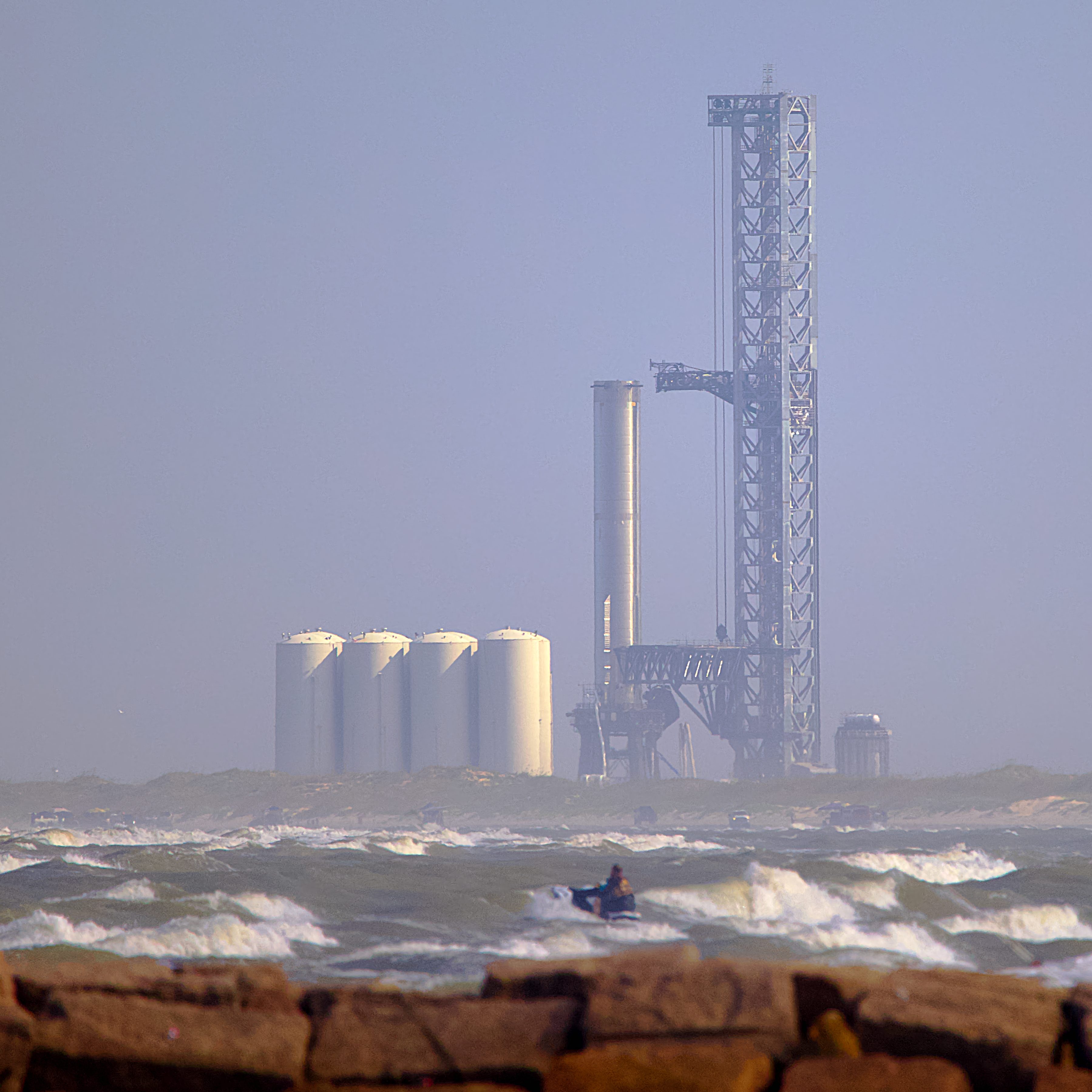
Launch Viewing
The closest public viewing point is expected to be on South Padre Island about eight kilometers (five miles) away. Despite uncertainties in the exact dimensions of the exclusion zone, it will certainly be large due to the size of Starship/SuperHeavy and the fact that it is an unproven rocket.
If attending in person is not an option, Everyday Astronaut will be live on location from Studio B with views all around the island and pad. Tim will be available to answer questions. A livestream link can be found here once we get closer to launch.
SpaceX is also expected to have an official live stream on X (formerly Twitter).
Starship/Super Heavy
For the past seven years, SpaceX has been developing their facility in Boca Chica, Texas. They have dubbed it “Starbase” and it contains tents, bays of various heights and widths, as well as all the infrastructure to produce the world’s largest and most powerful rocket. Information on the test campaign can be found in the “History” section below.
The full stack consists of two vehicles, each with different jobs relating to the launch process. On the bottom is the booster, also known as Super Heavy, which makes up about 58% of the full stack. The orbital ship rests on top of the booster to enable easy separation during staging.
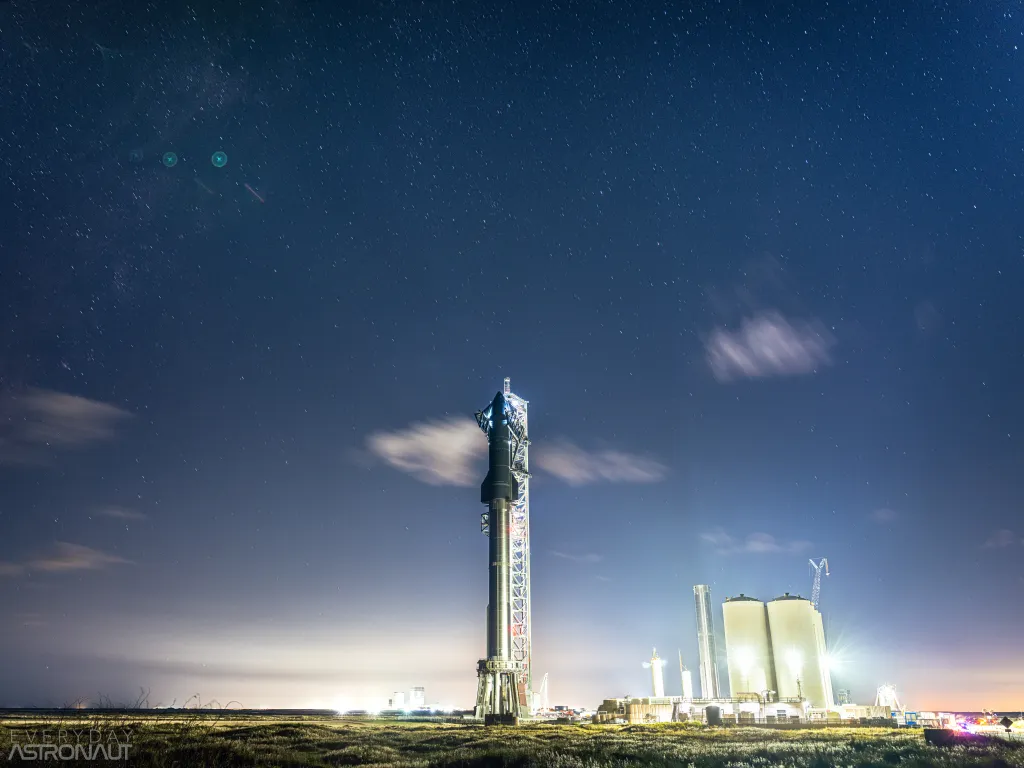
The Booster
The booster, or bottom part of the rocket, is powered by 33 Raptor 2 engines formed in a series of rings, stands 69 m (230 ft) tall. To fuel all 33 engines, the booster uses a liquid oxygen (LOx) tank and a methane (CH4) tank on the bottom and top, respectively. The booster is fueled by the Booster Quick Disconnect (BQD) which is located on the Orbital Launch Table and connects to the booster near the bottom.

Shortly before the booster experiences first motion, the BQD retracts and a protective door rapidly shuts in order to prevent the connections from getting blasted by rocket engine exhaust. Near the bottom of the booster are four elongated triangular chines. Each of these contain Composite Overwrapped Pressure Vessels (COPVs). The COPVs provide helium and other gasses for engine start up and other functions on the booster. The square trapezoidal pyramids mainly contain electronics units.
On the top of the booster are four grid fins which provide control during booster descent through the atmosphere. These work similarly on the Falcon 9, however are much larger on Super Heavy. On top of the grid fins is a hot staging ring, where the ship is mounted.
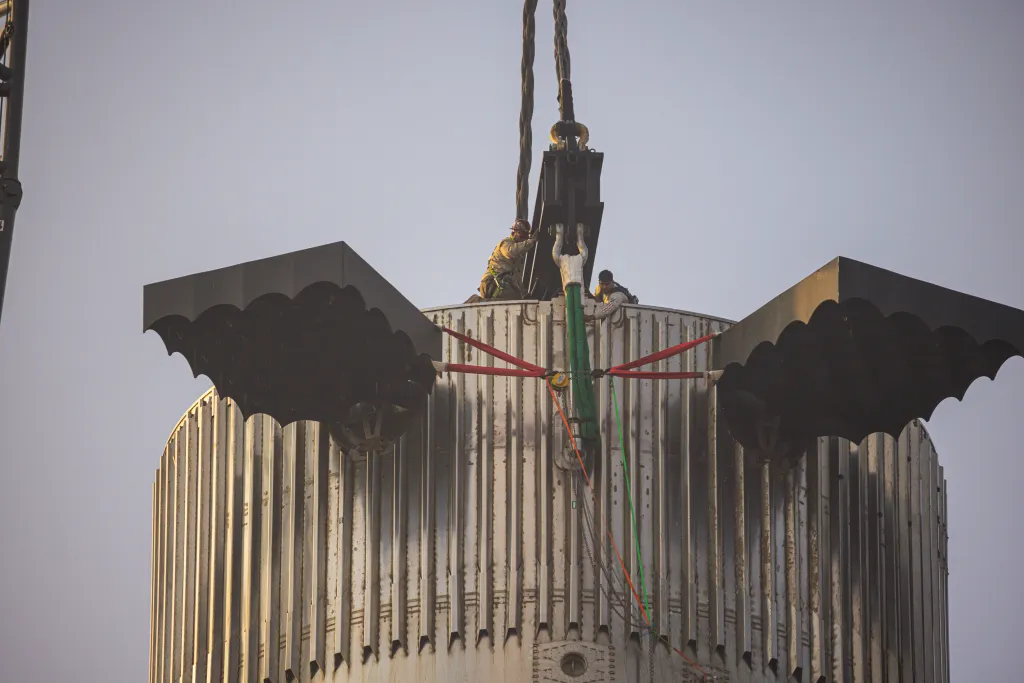
All 33 sea-level Raptor 2 engines are arranged in three clusters or rings. The three inside engines form a triangle and have the ability to gimbal. The next ring contains 10 engines which also have the ability to gimbal. Finally, the outer ring contains the remaining 20 engines that do not have the ability to gimbal.
During hot staging, only the three center engines stay ignited. After staging is completed, the inner ring of engines relight to assist with the boostback burn.
The Ship
Starship, or the top part of the rocket, is powered by three sea-level Raptor 2 engines, and three vacuum optimized Raptor 2 engines, standing an overall 50 m (160 ft) tall. The three vacuum optimized engines have elongated bells to adapt to the lack of air pressure in space. To learn more about Raptor engine development, check out Everyday Astronaut’s video “How SpaceX Is Upgrading Raptor To Be The Ultimate Rocket Engine!“
On the bottom of the ship is a skirt which encloses the engines and provides a structural element for the booster and ship to connect. Unlike the Falcon 9, the interstage section on Starship is on the ship and the top of the booster is the hot staging ring. During stage separation, all six Raptor engines on Starship will ignite, pushing the vehicle away from the booster. This is possible because of the addition of a hot stage ring that allows the exhaust from Starship’s engines to expand outwards.

The bigger of the two sets of flaps, the aft flaps can work in conjunction with the three center mounted sea-level engines which gimbal, to orient the ship during entry, descent, and landing. On the top of the ship, are the slightly smaller forward flaps that also aid in ship orientation during entry, descent, and landing.
About two-thirds of the way up the vehicle is the payload bay. Designed for Starlink satellites, there is a narrow door that deploys one satellite at a time. Sometimes called the “PEZ dispenser,” named after the popular candy, the internal structure of the payload bay is specially designed to deploy Starlink satellites in this manner.
COUNTDOWN
All times approximate
| HR/MIN/SEC | EVENT |
|---|---|
| 01:15:00 | SpaceX Flight Director conducts poll and verifies GO for propellant load |
| 00:53:00 | Ship LOX (liquid oxygen) load underway |
| 00:51:00 | Ship fuel (liquid methane) load underway |
| 00:42:00 | Booster LOX load underway |
| 00:41:00 | Booster fuel load underway |
| 00:19:40 | Raptor begins engine chill on booster and ship |
| 00:03:30 | Booster propellant load complete |
| 00:02:50 | Ship propellant load complete |
| 00:00:30 | SpaceX flight director verifies GO for launch |
| 00:00:10 | Flame deflector activation |
| 00:00:03 | Raptor ignition sequence begins |
| 00:00:00 | Excitement guaranteed |
FLIGHT TEST TIMELINE | BEST CASE SCENARIO
All times are approximate
| HR/MIN/SEC | EVENT |
|---|---|
| 00:00:02 | Liftoff |
| 00:00:52 | Max Q (moment of peak mechanical stress on the rocket) |
| 00:02:42 | Booster MECO (most engines cut off) |
| 00:02:44 | Hot-staging (Starship Raptor ignition and stage separation) |
| 00:02:55 | Booster boostback burn startup |
| 00:03:50 | Booster boostback burn shutdown |
| 00:06:36 | Booster is transonic |
| 00:06:46 | Booster landing burn startup |
| 00:07:04 | Booster landing burn shutdown |
| 00:08:35 | Starship engine cutoff |
| 00:11:56 | Payload door open |
| 00:24:31 | Propellant transfer demo |
| 00:28:21 | Payload door close |
| 00:40:46 | Raptor in-space relight demo |
| 00:49:05 | Starship entry |
| 01:02:16 | Starship is transonic |
| 01:03:04 | Starship is subsonic |
| 01:04:39 | An exciting landing! |
Starship Program History
For nearly all of its lifetime, the Starship program has resided in south Texas, at Starbase. The area where Starbase resides has changed names many times over the past decades. The town where Starbase is located was originally called Kennedy Shores. After a hurricane it was renamed Kopernik Shores, and most recently is known as Boca Chica.
Originally purchased in 2014, the land in the area of Boca Chica gradually fell into SpaceX’s hands. For the next four years, progress was fairly dormant, despite some occasional ground work. In 2018, a water tower-like structure first stood on the paper-flat landscape. This “water tower” would be later known as Starhopper, a Raptor engine test vehicle.
Test Hops
Starhopper flew untethered for the first time on July 25, 2019 under the power of one Raptor engine serial number six to a height of 20 m (65 ft). A little over a month later, Starhopper would fly for the second and final time, reaching a height of 150 m (500 ft). The main purpose of Starhopper was as a Raptor flight test vehicle. Presently, Starhopper remains at the launch site, covered in speakers, cameras, and other communication and monitoring equipment.
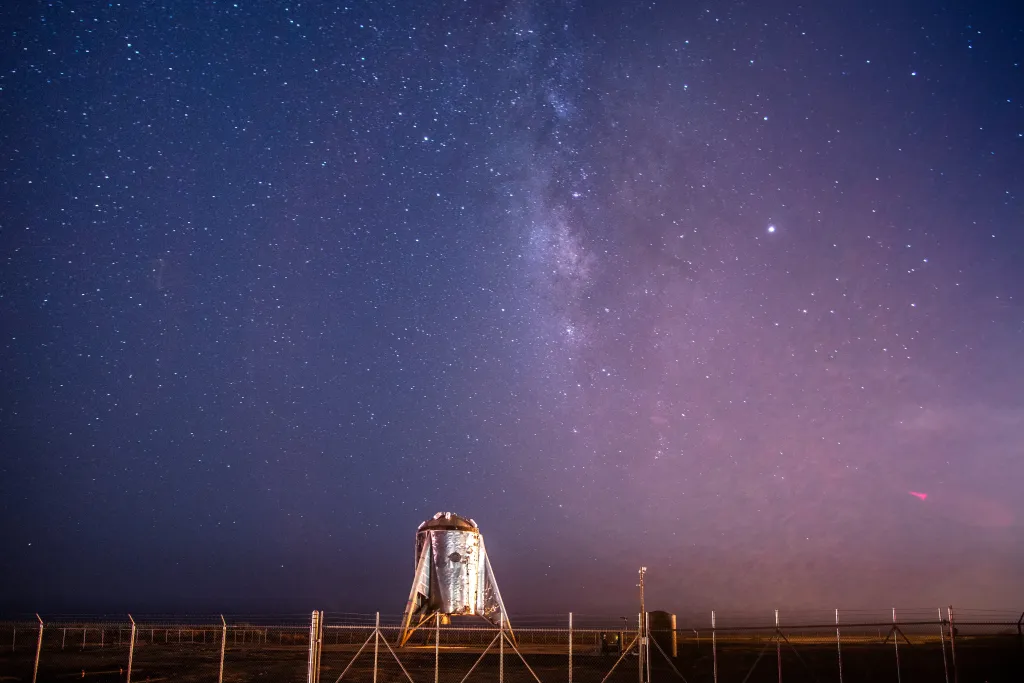
Two more test vehicles would fly to a height of 150 m (500 ft), SN5 and SN6. However, before these two successes came the spectacular malfunction of SN4. While conducting a static fire test, SN4 suffered an explosion, or a rapid unscheduled disassembly, which quickly ended its testing career. SN5 and SN6 would launch a year after Starhopper, about one month apart.
First Flights
At this point, SpaceX transitioned to higher flights which would utilize three Raptor engines and aimed to test the belly flop, flip, and landing maneuver. The first Starship to attempt this maneuver would be SN8, which launched on December 9, 2020 and flew to an altitude of 12.5 km (41,000 ft). Flying for a total duration of six minutes, 42 seconds, the flight concluded in SN8 crashing on the landing pad. A sudden pressure loss in the methane header tank caused the engines to stop producing thrust, resulting in a rapid unscheduled disassembly of the vehicle.
SN9 would be next up in line to attempt a successful landing. SN8 had already proved that Starship could perform a belly-side-down dive, relight its engines, and (partially) flip over. During construction, SN9 fell over in the High Bay which caused concern for its structural integrity. SN9’s flight was the same as SN8, however, it only traveled to 10 km (33,000 ft) in altitude. Upon landing, one of its three Raptor engines failed to relight resulting in an over-rotation of the vehicle. SN9 landed at a slight angle and exploded on the landing pad.
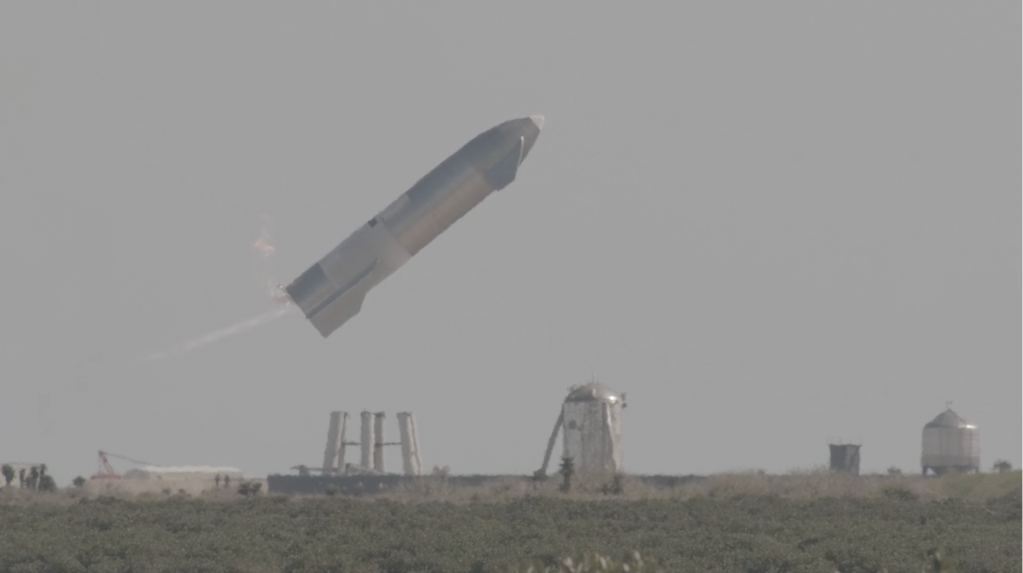
SN10’s flight came with an emotional roller coaster. As its predecessor did, SN10 flew to 10 km (33,000 ft) and performed its descent maneuver as designed. The flip and engine relight went smoothly, but a hard touchdown damaged the skirt and fragile landing legs. After standing poised on the landing pad, about eight minutes later, SN10 also exploded in a massive fireball.
Explosion And Success
SN11 still remains a large mystery. Due to the abnormally dense and low lying fog, the entire flight was entirely obscured, leaving the only evidence of flight to the in-person observer, the sound, and a still image captured by Trevor Mahlman. Upon relight and shortly before landing, SN11 rapidly exploded, scattering debris across the area around Starbase for miles. The only visuals of this explosion were from ground based cameras that saw debris falling from the sky.
Finally, SN15 was the first Starship prototype to fly to 10 km (33,000 ft), dive down on its belly, flip, and land successfully. The prototypes between SN11 and SN15 allowed for necessary upgrades which enabled a successful landing. While a small fire ignited underneath the vehicle, it was quickly extinguished allowing SN15 to live on. Currently, SN15 sits with other vehicles in the Rocket Garden.
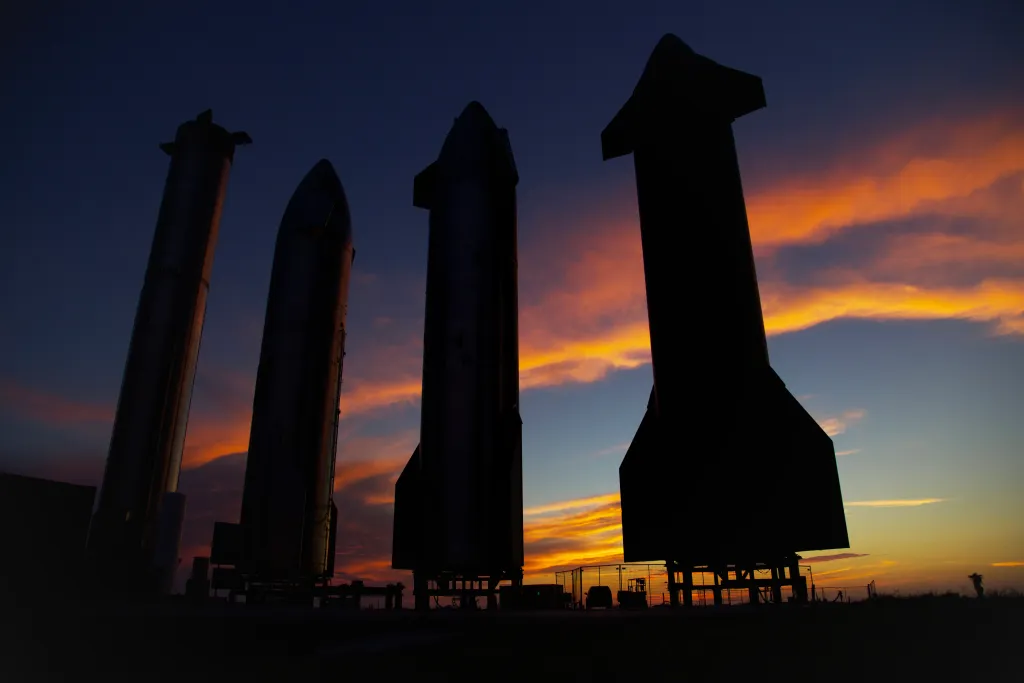
Recent Updates
Although SN15, which flew almost two and a half years ago in May 2021, was the last flight from Starbase, testing and rapidly accelerated construction has progressed and changed the landscape. Some highlights of this construction include the completion of the Orbital Launch Tower and Orbital Tank Farm. Both of these elements, in conjunction with the Orbital Launch Table, are essential parts of Stage Zero. Stage Zero is, simply put, the launch pad and supporting equipment that enables an orbital launch.
As far as rockets go, SpaceX tested BN3 (Booster Number 3) marking the first static fire of a booster prototype on July 19, 2021. BN3 was quickly scrapped a month later, but paved the way for B4 (Booster 4), which never performed a static fire test, but was part of the first full stack of the Starship/SuperHeavy launch system.
Conclusion
All of the previous test articles paved the way for Booster 7 and Ship 24 to conduct the first orbital flight test. Each explosion, successful landing, static fire test, cryogenic proof test, and even simple rollouts to the pad have allowed SpaceX to test critical elements in preparation for orbital flight. Both of the previous two test flights have gathered more and more data that will, without a doubt, launch flight 3 further into the cosmos.
Expected Milestones
| Event | Date/Status (UTC) |
|---|---|
Starship Test Flight | March 14, 2024 |
FAA Launch License | Received on March 13 |
FAA Mishap Investigation | Completed |
Flight Road Closure | In place for March 14-16 |
Temporary Flight Restriction (TFR) Mexico | Received on March 07 (for March 14-16) |
Temporary Flight Restriction (TFR) USA | TBD |
Evacuation Notice | TBD |
Marine Hazard Zones | Posted on March 06 (for March 14) |
Wet Dress Rehersal | March 03/04, 2024 |
First Full Stack | February 11, 2024 |
Ship 28 Engine Testing | December 20, 2023 |
Ship 28 Rollout | December 14, 2023 |
Ship 28 Thermal Protection System (TPS) Installation | Complete |
Ship 28 6 Engine Install | Middle 2023 |
Booster 10 Static Fire | December 29, 2023 |
Booster 10 Cryo Test (Masseys) | Middle/End 2023 |
Booster 10 Rollout | December 18, 2023 |
Booster 10 33 Engine Install | Middle 2023 |
| Completed | In Progress | TBD |
Live Updates:
March 14, 2024
Flight completed.
March 03/04, 2024
Wet Dress Rehearsal of B10 and S28 completed.
December 29, 2023 – 16:46 UTC [10:46 CST]
Booster 10 static fire. All 33 engines ignited.
December 29, 2023 – 15:19 UTC [09:19 CST]
Ship 28 single engine static fire. “Demonstrating a flight-like startup for an in-orbit burn,” SpaceX.
December 20, 2023 – 19:37 UTC [13:37 CST]
Ship 28 static fire.
December 18, 2023 – 10:55 UTC [04:55 CST]
Booster 10 is en-route to the launch site.
December 16, 2023 – 17:59 UTC [11:59 CST]
Ship 28 has completed a Spin Prime test.
December 14, 2023 – 10:59 UTC [04:59 CST]
Ship 28 has been rolled out to Suborbital Pad B.




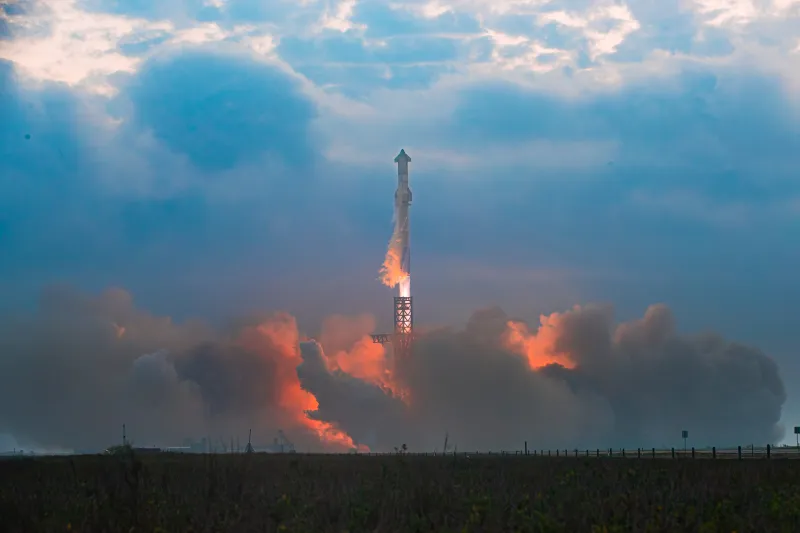
In the first paragraph you state that “The vehicles that will most likely be attempting the third flight test are Ship 28 and Booster 11.” I thought Booster 10 was next. Thoughts?
Very nicely put together and informative article. Thank you!
This was a great read!
A very comprehensive insight on all steps that have brought starship to its present level of accomplishment. Kudos.
Love your work. Please stick to Metric; using imperial is so last century.
Hi, Something’s clobbered in the “Where to watch” paragraph which makes it into gibberish. I’m viewing on Android Chrome browser.
Agree, it looks terrible on mobile, but good in desktop mode.
I’ll be honest, the checklist is pretty badly out of date.
The checklist needs updating I believe.
The checklist really needs an update, like yesterday.
Great article!!👍
Last fall SpaceX overtook China Aerospace as the most prolific launch provider with a rapid end of year cadence that was spectacular. Just a few months later, today SpaceX leads China Aerospace by 25 launches to orbit. And in a few more months, will become more prolific than all Chinese launches combined. And sometime next year SpaceX will have completed more launches than all Chinese and Russian launches combined. And in the following year is likely to have launched more than the sum of every other entity.
Pretty awesome for the SpaceX team to pull off, in just a few short years since Falcon 9 became the worlds space workhorse. We really need to give the SpaceX team a huge attaboy for stepping up to Musk’s vision, and pulling it off.
need to update FAA licence out
Go Starship!!! Go Musk!! Go SpaceX Team!!!
Now it’s on the Previous launches page – it’s shown green as success. I’m a Starship fan but it wasn’t an unqualified success – Booster failed to relight for landing burn, and Ship lost control, rolling all through reentry and not keeping TPS towards the airstream. Also the Raptor relight in orbit didn’t happen.
And a few tens of thousands of other critical design decisions were validated as successful, leaving a few to be resolved next flight.
I’d also like to bring up that success in this industry is reaching intended orbit, exactly the same success definition of every other expendable rocket … since both the first stage (Super Heavy) and the second stage (Starship) were designated as expendable in this launch. Each of the failed items are extra, and not attempted by any other launch provider … controlled re-entry and landing (simulated or real), which is the learning part of these Starship launches, things without a history in the industry, pure path finder trial and error development processes.
In this case learning from these attempts is a pure success as well, were failure can only be defined as failing early, preventing the successful learning attempt. So yes, this Starship launch was also a successful attempt to learn the do’s and dont’s necessary to reach successful re-entry and landings in the future.
The biggest failure, is the failure to try … which every other launch provider … is surely guilty of. And for that simple reason, the SpaceX engineering team are ABSOLUTE Hero’s … going where no man (or woman) has gone before, into the unknown.
To try and shame this team as failures, really is a failure as a human being, making fun of the brightest and best, by someone that is part of the failure to try masses, and far lesser human beings for attempting that shaming of our greatest for actually succeeding to learn, by being willing to learn with each negative outcome toward success.
Just a few years ago, lesser humans were crowing at each failed landing that the Falcon 9 team had, which was equally poor character on their part. The Super Hero engineering team at SpaceX learned from each negative outcome, proved the crowing detractors wrong in the end with a highly reliable Falcon 9 that sticks every landing. Today the Falcon 9’s are refurbished with minor effort, and have slashed the launch prices to the bone, basically just the cost of fuel, and cost for facilities and staff to maintain the rockets and launch them.
Today Spacex has a fleet of durable Falcon 9 refurbished launch vehicles setting records each week, most of which have flown more than a dozen times, rapidly approaching two dozen times:
Falcon 9 Block 5 booster B1062-19; 44.93-day turnaround
Falcon 9 Block 5 booster B1063-17; 47.15-day turnaround
Falcon 9 Block 5 booster B1077-11; 40.25-day turnaround
Falcon 9 Block 5 booster B1073-13; 49.92-day turnaround
Falcon 9 Block 5, booster B1081-5; 25.65-day turnaround
Falcon 9 Block 5 booster B1076-11; 56.68-day turnaround
Falcon 9 Block 5 booster B1069-13; 58.75-day turnaround
Funny the detractors never seem able to admit they were wrong, with a pure lack of humility.
Add a few more to the fleet of durable Falcon 9 refurbished launch vehicles list:
Falcon 9 Block 5 booster B1067-18; 39.20-day turnaround
Falcon 9 Block 5 booster B1060-19; 37.88-day turnaround
Falcon 9 Block 5 booster B1080-6; 62.96-day turnaround
Falcon 9 Block 5 booster B1075-10; 49.85-day turnaround
Falcon 9 Block 5 booster B1071-15; 50.08-day turnaround
Buggy-whip fans also naysayed the invention of the automobile. Nattering nabobs of negativism are par for the course of technological evolution